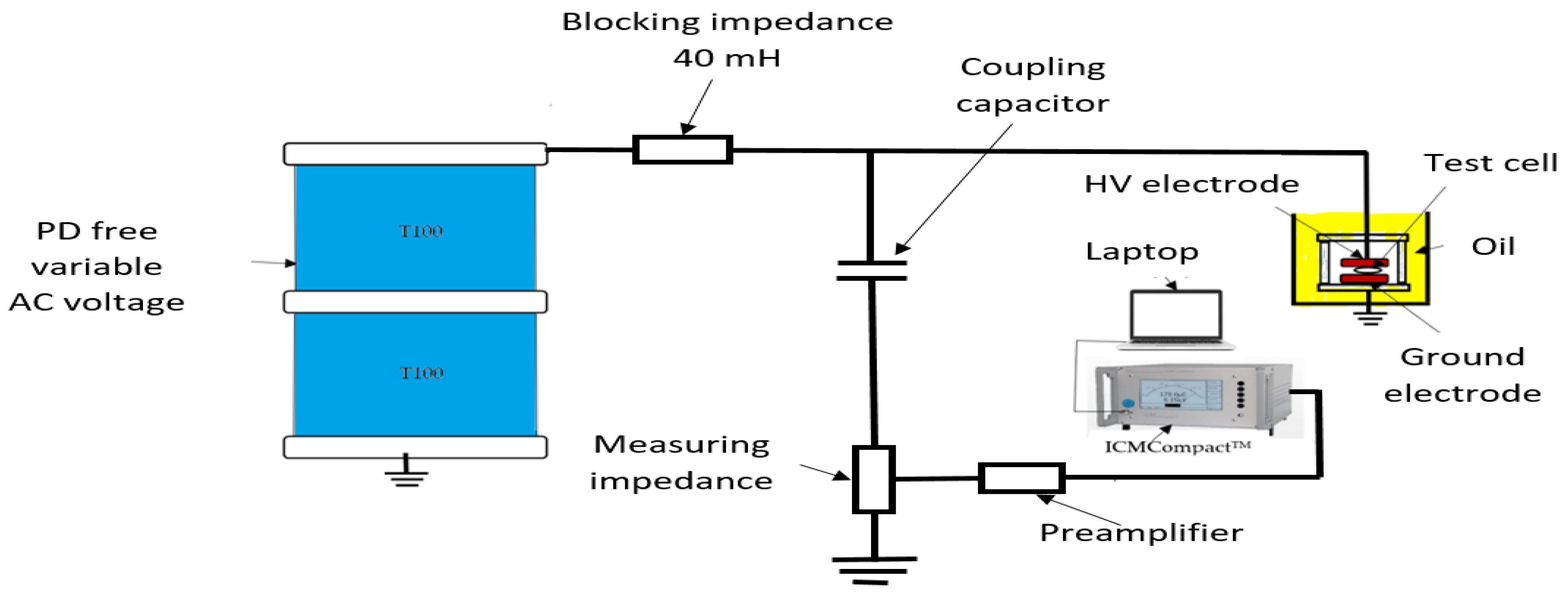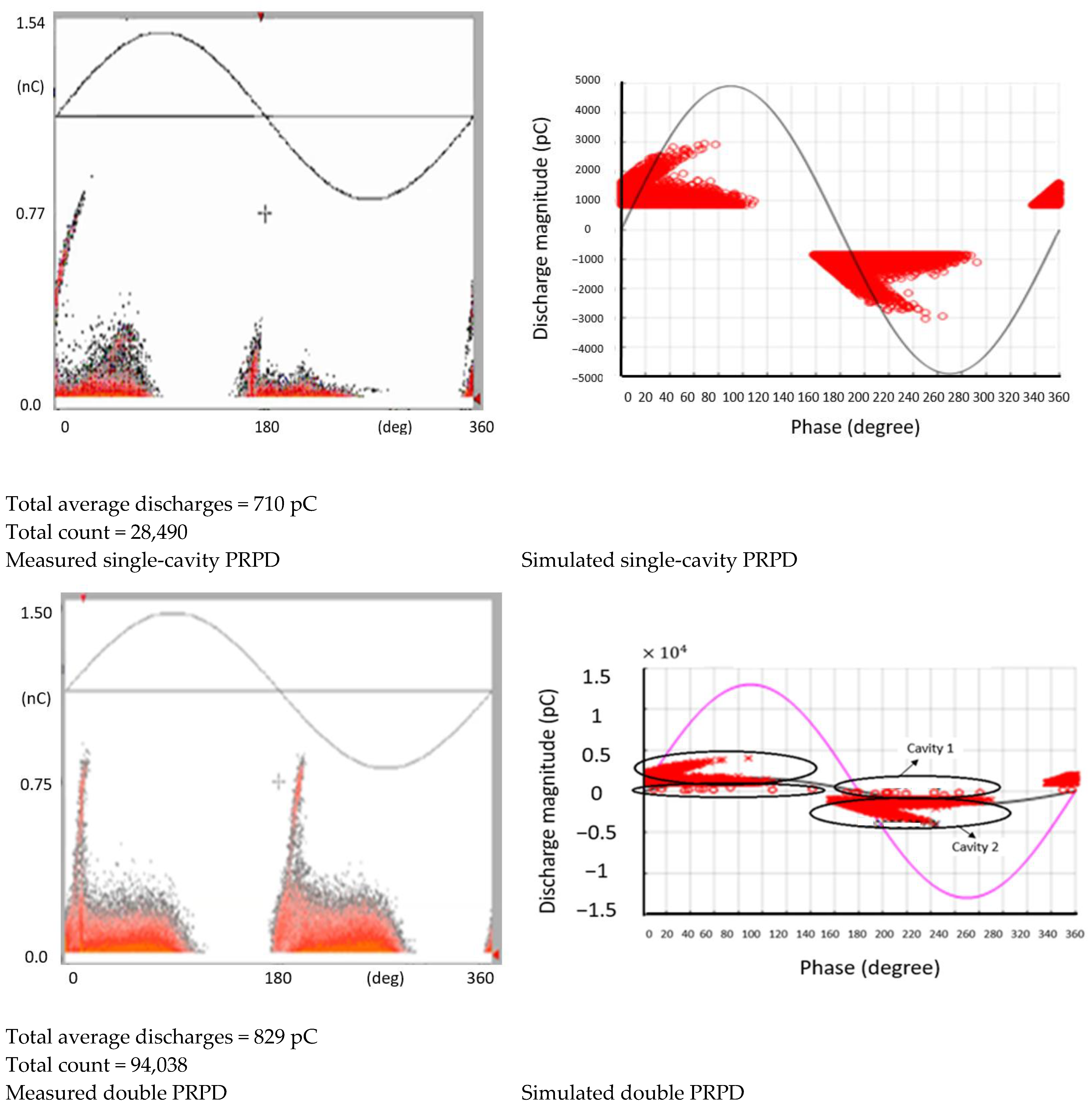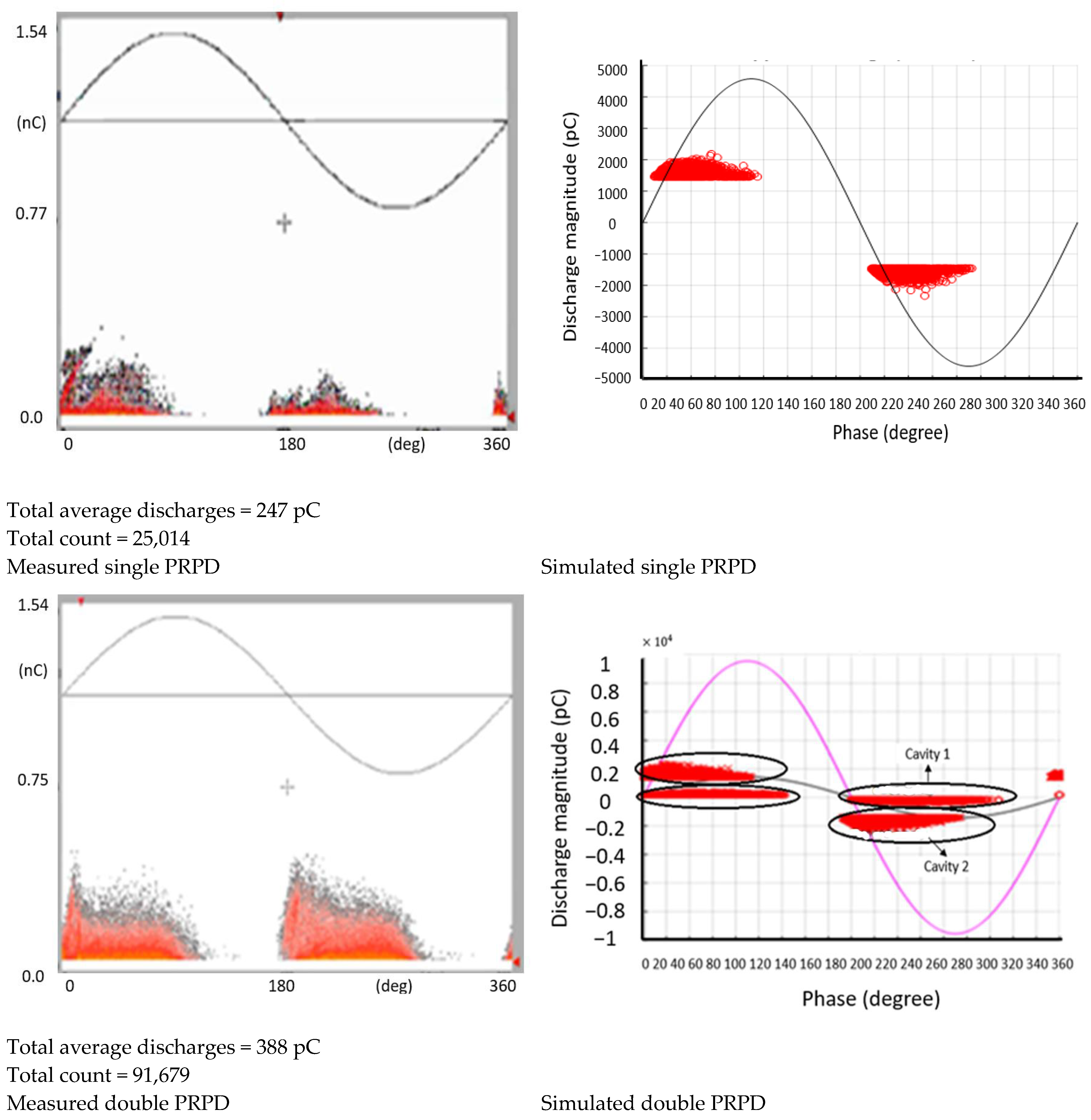A Comparative Study of Time-Evolution Characteristics of Single and Double Cavity Partial Discharges
Abstract
:1. Introduction
2. The Evolutionary Nature of Partial Discharges: A Review of Existing Knowledge
3. Experimental Design
PD Test Cell Setup
4. Results Analysis and Discussion
Single and Double Cavities’ Time Evolution
- is the fundamental phonon frequency.
- Φ is the effective work function for detrapping.
- is the Schottky term.
- K is the Boltzman constant.
- T is the absolute temperature
- Ndt accounts for the number of detrappable electrons.
- ζ < 1 is a dimensionless factor for detrappable electrons that accounts for the difference in efficiency when the surface is impacted by a positive ion (normal condition) or an electron (polarity reversed).
- q is the true PD charge.
- e is the elementary charge
- t is the time interval since the previous discharge event
- is the effective decay time constant.

5. Conclusions
- This work confirmed the existing knowledge that PD phase-resolved patterns of air-filled cavity defects in polymer materials evolve through distinct stages as the PD activity progresses from inception to complete failure.
- The overall shapes of PD phase-resolved patterns of single cavities and those of closely coupled cavities evolve in a similar way and are therefore difficult to distinguish. This is because the same PD mechanisms are present in both double and single cavities. This is not surprising as the physics of the PD discharge does not depend on the configuration of the cavities.
- By using a suitable PD simulation model and a curve-fitting approach in reproducing physically measured PD patterns, the dominant variables responsible for time-dependent PD pattern evolution changes were identified.
Author Contributions
Funding
Data Availability Statement
Conflicts of Interest
References
- IEEE Std 493-2007 Revis; IEEE Recommended Practice for the Design of Reliable Industrial and Commercial Power Systems. IEEE: New York, NY, USA, 2007.
- Kulkarni, S.V.; Khaparde, S.A. Transformer Engineering: Design, Technology, and Diagnostics, 2nd ed.; CRC Press: New York, NY, USA, 2012; ISBN 978-1-4398-5377-1. [Google Scholar]
- Chanda, M.; Roy, S.K. Industrial Polymers, Specialty Polymers, and Their Applications, 1st ed.; CRC Press: Boca Raton, FL, USA, 2008. [Google Scholar]
- Tenbohlen, S.; Coenen, S.; Djamali, M.; Müller, A.; Samimi, M.H.; Siegel, M. Diagnostic Measurements for Power Transformers. Energies 2016, 9, 347. [Google Scholar] [CrossRef]
- Tanaka, T. Internal partial discharge and material degradation. IEEE Trans. Electr. Insul. 1986, EI-21, 899–905. [Google Scholar] [CrossRef]
- Morshuis, P.H.F. Degradation of solid dielectrics due to internal partial discharge: Some thoughts on progress made and where to go now. IEEE Trans. Dielectr. Electr. Insul. 2005, 12, 905–913. [Google Scholar] [CrossRef]
- Stone, G.C. Partial discharge diagnostics and electrical equipment insulation condition assessment. IEEE Trans. Dielectr. Insul. 2005, 12, 891–904. [Google Scholar] [CrossRef]
- IEC60270; High-Voltage Test Techniques—Partial Discharge Measurements. International Electrotechnical Commission: Geneva, Switzerland, 2000.
- Ahmed, N.; Srinivas, N. PD types and their detection possibilities by PD test methods. In Proceedings of the 2001 Annual Report Conference on Electrical Insulation and Dielectric Phenomena, Kitchener, ON, Canada, 14–17 October 2001; pp. 307–310. [Google Scholar]
- Seghir, T.; Mahi, D.; Lebey, T.; Malec, D. Analysis of the electric field and the potential distribution in cavities inside solid insulating electrical materials. In Proceedings of the COMSOL User Conference, Paris, France, 7 November 2006. [Google Scholar]
- Boggs, S.A. Partial discharge. iii. cavity-induced PD in solid dielectrics. IEEE Electr. Insul. Mag. 1990, 6, 11–16, 19–20. [Google Scholar] [CrossRef]
- Kuffel, E.; Zaengl, W.S.; Kuffel, J. High Voltage Engineering Fundamentals, 2nd ed.; Elsevier: Amsterdam, The Netherlands, 2000. [Google Scholar]
- Boggs, S.; Densley, J. Fundamentals of partial discharge in the context of field cable testing. IEEE Electr. Insul. Mag. 2000, 16, 13–18. [Google Scholar] [CrossRef]
- Morshuis, P.H.F.; Kreuger, F.H. Transition from streamer to Townsend mechanisms in dielectric voids. J. Phys. D Appl. Phys. 1990, 23, 1562–1568. [Google Scholar] [CrossRef]
- Gulski, E.; Kridva, A. Influence of aging on classification of PD in HV components. IEEE Trans. Dielectr. Electr. Insul. 1995, 2, 676–684. [Google Scholar] [CrossRef]
- Komori, F.; Kojima, A.; Hikita, M.; Suzuoki, Y.; Mizutani, T. Phase-resolved study on partial discharge for degradation diagnosis in polymeric insulating materials using model electrode system. In Proceedings of the 1998 IEEE 6th International Conference on Conduction and Breakdown in Solid Dielectrics (Cat. No.98CH36132), Vasteras, Sweden, 22–25 June 1998; pp. 153–156. [Google Scholar]
- Seanor, D.A. Electrical Properties of Polymers; Academic Press, Inc.: Cambridge, MA, USA, 1982; Chapter 1; pp. 1–10. [Google Scholar]
- Montanari, G.C. Online partial discharge diagnosis of power cables. In Proceedings of the IEEE Electrical Insulation Conference, Montreal, QC, Canada, 31 May–3 June 2009; pp. 210–215. [Google Scholar]
- Dodd, S.J.; Champion, J.V.; Vaughan, A.S.; Sutton, S.J.; Swingler, S.G. The influence of morphology on electrical treeing in polyethylene blends. Proc. Sci. Meas. Technol. 2003, 150, 58–64. [Google Scholar] [CrossRef]
- Krueger, F.H. Discharge Detection in High Voltage Equipment; Temple Press Books Ltd.: London, UK, 1964. [Google Scholar]
- Mizutani, T.; Kondo, T.; Nakao, K. Change in partial discharge properties of a void in LDPE. In Proceedings of the Annual Report Conference on Electrical Insulation and Dielectric Phenomena, Austin, TX, USA, 17–20 October 1999; Volume 1, pp. 257–260. [Google Scholar]
- Mizutani, T.; Kim, C.-S.; Ichikawa, K.; Tani, Y. Changes in PD pattern and PD current shape for a void in LDPE. In Proceedings of the Annual Report Conference on Electrical Insulation and Dielectric Phenomena (Cat. No.00CH37132), Victoria, BC, Canada, 15–18 October 2000; Volume 2, pp. 670–673. [Google Scholar]
- Ijichi, K.W.T.; Kojima, A.; Komori, F.; Suzuoki, Y. Influence of PD rest time on φ-q-n patterns from voids. In Proceedings of the 2001 IEEE 7th International Conference on Solid Dielectrics (Cat. No.01CH37117), Eindhoven, The Netherlands, 25–29 June 2001; pp. 93–96. [Google Scholar]
- Wu, K.; Suzuoki, Y.; Dissado, L.A. Improved Simulation model for PD pattern in voids considering effects of discharge area. In Proceedings of the Annual Report Conference on Electrical Insulation and Dielectric phenomena, Albuquerque, NM, USA, 19–22 October 2003; pp. 32–35. [Google Scholar]
- Guo, D.; Hepburn, D.M.; Nesbitt, A.; Zhou, C. Change in pattern of void-type PD with ageing. In Proceedings of the International Conference on Condition Monitoring and Diagnosis, Beijing, China, 21–24 April 2008; pp. 109–112. [Google Scholar]
- Nyamupangedengu, C. Time-varying partial discharge spectral characteristics in solid polymer insulation. IET Sci. Meas. Technol. 2012, 6, 85–95. [Google Scholar] [CrossRef]
- Danikas, M.G.; Morsalin, S. Foreign Inclusions, Enclosed Cavities, Partial Discharge Models and Discharge Energy: A Short Review Regarding Solid Dielectrics and Composite Insulating Systems. Eng. Technol. Appl. Sci. Res. 2019, 9, 4659–4666. [Google Scholar] [CrossRef]
- Kuebler, B. Investigations of Partial Discharge Measuring Techniques Using Epoxy Resin Samples with Several Voids. In Proceedings of the 1978 IEEE International Conference on Electrical Insulation, Philadelphia, PA, USA, 12–14 June 1978; pp. 82–85. [Google Scholar]
- Danikas, M.G. Partial discharge behavior of two (or more) adjacent cavities in polyethylene samples. J. Electr. Eng. 2001, 52, 36–39. [Google Scholar]
- Agoris, D.P.; Hatziargyriou, N.D. Two voids model for simulation of partial discharges in solid dielectrics. Model. Simul. Control 1992, 42, 1–14. [Google Scholar]
- Agoris, D.P.; Hatziargyriou, N.D. Approach to partial discharges development in closely coupled cavities embedded in solid dielectrics by the lumped capacitance model. IEE Proc.-A 1993, 140, 131–134. [Google Scholar] [CrossRef]
- Agoris, D.P.; Hatziargyriou, N.D. A modelistic consideration of the interaction between discharges in cavities of solid dielectrics. In Proceedings of the 8th International Symposium on High Voltage Engineering, Yokohama, Japan, 23–27 August 1993. [Google Scholar]
- Agoris, D.P.; Hatziargyriou, N.D. Application of the EMTP program in the study of discharges in two cavities enclosed in a solid dielectric during its stressing with AC or impulse voltage. In Proceedings of the CIGRE Greek National Committee, Athens, Greece, 10–11 February 1994. [Google Scholar]
- Illias, H.A.; Chen, G.; Lewin, P.L. Measurement of Partial Discharge Activities within Two Artificial Spherical Voids in an Epoxy Resin. In Proceedings of the Annual Report Conference on Electrical Insulation and Dielectric Phenomena, Cancun, Mexico, 16–19 October 2011; pp. 489–492. [Google Scholar]
- Illias, H.; Chen, G.; Lewin, P.L. Modelling of partial discharge activity in spherical cavities within a dielectric material. IEEE Electr. Insul. Mag. 2011, 27, 38–45. [Google Scholar] [CrossRef]
- Illias, H.A.; Chen, G.; Bakar, A.H.A.; Mokhlis, H.; Tunio, M.A. Partial discharges within two spherical voids in an epoxy resin. J. Phys. D Appl. Phys. 2013, 46, 335301. [Google Scholar] [CrossRef]
- Pan, C.; Chen, G.; Tang, J.; Wu, K. Numerical Modeling of Partial Discharges in a Solid Dielectric-bounded Cavity: A Review. IEEE Trans. Dielectr. Electr. Insul. 2019, 26, 981–1000. [Google Scholar] [CrossRef]
- Chang, C. Degradation by Partial Discharge in Cavities under AC Electric Field. Master’s Dissertation, University of Southampton, Southampton, UK, 2015. [Google Scholar]
- Pedersen, A.; Crichton, G.C.; McAllister, I.W. The functional relation between partial discharges and induced charge. IEEE Trans. Dielectr. Electr. Insul. 1995, 2, 535–543. [Google Scholar] [CrossRef]
- Ehara, Y.; Ito, T.; Kishida, H.; Sakai, T.; Ito, M. Characteristics of Gaseous Discharges Products and Discharge Magnitude Distribution in Void Discharge Deterioration. Trans. Inst. Electr. Eng. 1992, 112, 643–650. [Google Scholar]
- Ito, T.; Sato, O.; Sakai, T.; Ehara, Y. Analysis of Internal Discharge Degradation of Polyethylene by Simultaneous Chemical and Electrical Measurement. Trans. Inst. Electr. Eng. Jpn. (IEE) 1989, 109, 457–463. [Google Scholar]
- Liao, R.; Yan, J.; Yang, L.; Zhu, M.; Liu, B. Study on the relationship between damage of oil-impregnated insulation paper and evolution of phase-resolved partial discharge patterns. Eur. Trans. Electr. 2011, 21, 2112–2124. [Google Scholar] [CrossRef]
- Gjaerde, A.C. Measurement of Void Gas Pressure during Combined Thermal and Partial Discharge Ageing of Epoxy. IEE Proc. Sci. Meas. Technol. 1995, 142. [Google Scholar] [CrossRef]
- Gutfleisch, F.; Niemeyer, L. Measurement and simulation of PD in epoxy voids. IEEE Trans. Dielectr. Electr. Insul. 1995, 2, 729–743. [Google Scholar] [CrossRef]
- Wang, L.E. Physical Model of PD Behavior and Relevant Damage Growth from Micro-Cavities in Polyethylene-Based Material under ac Voltage. Ph.D. Thesis, University of Bologna, Bologna, Italy, 2011. [Google Scholar]
- Illias, H.A.; Othman, M.E.; Tunio, M.A.; Bakar, A.H.A.; Mokhlis, H.; Chen, G.; Lewin, P.L.; Ariffin, A.M. Measurement and simulation of partial discharge activity within a void cavity in a polymeric power cable model. In Proceedings of the IEEE International Conference (ICSD) on Solid Dielectric, Bologna, Italy, 30 June–4 July 2013; pp. 105–108. [Google Scholar]
- Medoukali, H.; Guibadj, M.; Zegnini, B. Study of Electrical Constraints within Cavities in High Voltage Cables. Int. J. Comput. Exp. Sci. Eng. 2015, 1, 30–35. [Google Scholar] [CrossRef]
- Wang, L.; Testa, L.; Cavallini, A.; Montanari, G.C. Relation between the trend of partial discharges and aging models under AC voltage. In Proceedings of the IEEE 9th International Conference on the 220 Properties and Applications of Dielectric Materials, Harbin, China, 19–23 July 2009; pp. 268–271. [Google Scholar]
- Kim, C.S.; Kondo, T.; Mizutani, T. Change in PD pattern with aging. IEEE Trans. Dielectr. Electr. Insul. 2004, 11, 13–18. [Google Scholar]






| Reference | Defect Types | Parameters | Key Findings |
|---|---|---|---|
| Gulski & Krivda [15] |
|
|
|
| Komori et al. [16] |
|
|
|
| Mizutani & Kondo [21] |
|
|
|
| Mizutani et al. [22] |
|
|
|
| Ijichi et al. [23] |
|
|
|
| Wu et al. [24] |
|
|
|
| Guo et al. [25] |
|
|
|
| Nyamupangedengu [26] |
|
|
|
| Researchers | Defect Types | Parameters | Key Findings |
|---|---|---|---|
| Illias et al. [34] |
|
|
|
| Illias et al. [35] |
|
|
|
| Illias et al. [36] |
|
|
|
| Agoris & Hatziargyriou [32] |
|
|
|
| Pan et al. [37] |
|
|
|
| Danikas [29] |
|
|
|
Disclaimer/Publisher’s Note: The statements, opinions and data contained in all publications are solely those of the individual author(s) and contributor(s) and not of MDPI and/or the editor(s). MDPI and/or the editor(s) disclaim responsibility for any injury to people or property resulting from any ideas, methods, instructions or products referred to in the content. |
© 2024 by the authors. Licensee MDPI, Basel, Switzerland. This article is an open access article distributed under the terms and conditions of the Creative Commons Attribution (CC BY) license (https://creativecommons.org/licenses/by/4.0/).
Share and Cite
Kyere, I.K.; Nyamupangedengu, C.; Swanson, A.G. A Comparative Study of Time-Evolution Characteristics of Single and Double Cavity Partial Discharges. Energies 2024, 17, 1905. https://doi.org/10.3390/en17081905
Kyere IK, Nyamupangedengu C, Swanson AG. A Comparative Study of Time-Evolution Characteristics of Single and Double Cavity Partial Discharges. Energies. 2024; 17(8):1905. https://doi.org/10.3390/en17081905
Chicago/Turabian StyleKyere, Isaac Kwabena, Cuthbert Nyamupangedengu, and Andrew Graham Swanson. 2024. "A Comparative Study of Time-Evolution Characteristics of Single and Double Cavity Partial Discharges" Energies 17, no. 8: 1905. https://doi.org/10.3390/en17081905





